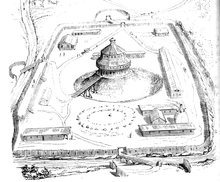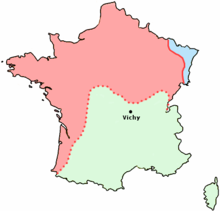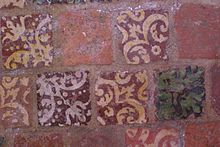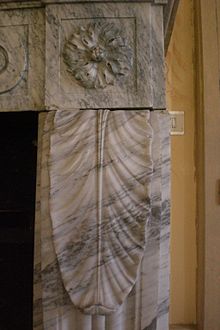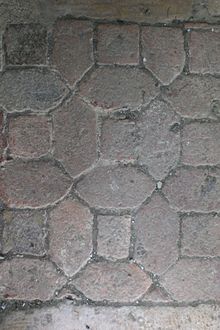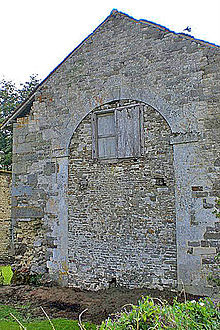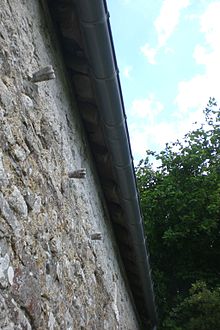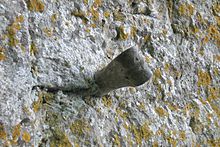- Château de la Motte, Joué du Plain
-
The Château de la Motte is a château located in the commune of Joué-du-Plain (Orne) in Lower Normandy, France. The Chateau began as a Viking motte and bailey fortress, and evolved into the 18th and 19th century Chateau seen today. The two most noted families who owned the site were the Gabriel Montgommerys, and the Nicolas Angos, but its role as Resistance center in World War II may be its most controversial story.
Introduction
Long established Norman chateaux, like Chateau de la Motte, usually originate from a motte and bailey castle constructed during the earliest Norman period.The bourgeois Ango family built much of Chateau de la Motte in the late 16 and early 1700s; however, they bought the original Chateau from one of the most noted names in Normandy: the descendants of Gabriel de Montgomery I (Montgommery). In 1559, Montgomery had accidentally killed King Henry II of France in a joust.
Château de la Motte sits at the end of a long chestnut tree alley linking to the commune of Joué-du-Plain and the village of Écouché. The Chateau’s former farm, with an arched entry and coat-of-arms may have been the original chateau built in the 1660s. Today's chateau and a number of buildings have dates from the early 1800s, after restorations from the Deschamps family's following the Revolution.
In World War II, the Chateau operated as a dairy and holiday home for Paris prostitutes. However, at the same time it functioned as headquarters for the Resistance. Escaping Allied pilots and an important arms depot were hidden here. The discovery of the depot by the Germans caused the assassination of the local mayor, and an unresolved crime, the subject of two criminal investigations and one book.
The vast majority of chateaux in France were modest like this one. This article relates the Chateau's history as a typical story of a small Chateau in Normandy, based on regional history and archaeology.
Name Origin, water sources and first historic mention
Château de la Motte takes its name from the small-forested rise next to the current château house, called a motte (“clod of earth” in Old French). The small mound is the remains of a Viking/Norman motte-and-bailey castle (motte castrale, motte féodale in Old French). Mottes were made throughout France and Europe from the 10th century until the early 13th century, with many sites carrying the title of La Motte, Les Mottes, Forêt de la Motte, or Château de la Motte.[1]
Site and Water Sources
Mottes often sat on Roman villa sites because water sources and strategic location needs were the same in both eras. Although numerous villa ruins were found nearby with the recent A 88 autoroute construction, it is unknown if this site was occupied before the Vikings, without archaeological excavation.[2]
The Château’s site, with the orchard and farm, has seven sources of water. Like most châteaux and mottes, this probably was the main consideration for the location. Wells and water management were important from earlier times as most drinking sources were contaminated, and sufficient water for animals was always a concern, even in water-soaked Normandy. Water pollution was a known source of sickness from antiquity onward, although poorly understood.[3]
[4] In the 1400s, when châteaux lost their defensive function, moats fulfilled prestige and esthetic roles as well as being fishponds, an important source of protein for peasants.[5]
First Historic Mention
The first mention of Château de la Motte is a letter from Guillame Lesor in 1217, asking to be a vassal of King of France. This letter follows the event of King John of England (1199–1216) having just lost the Battle of Bouvines in 1214, and had withdrawn from Normandy. [6]
Château Evolution
The first motte and bailey forts were built to nail down Viking/Norman power in Normandy, as the lords of Maine in the south, and Brittany, to the west, occasionally intruded in force. The course of the river Orne was the southernmost Norman boundary for much of the 900’s, and was defended by a series of mottes, usually in groups.[7][8]
Motte and bailey castles usually had two main parts, both surrounded by wet or dry moats, then wooden palisade. First constructed was the motte, or earthmound with a wooden tower on top. Then, the bailey ( la basse cours). The tower was a last defense in an attack, and a sometimes lord's residence. The bailey contained barns, barracks, a blacksmith, a chapel, and other support structures. A removable wooden bridge linked the tower to the courtyard, and a single fortified gate welcomed the visitor crossing the moat into the compound.
The motte may have been similar to one excavated nearby at Land de Goult, near Carrouges. Archeologists uncovered a lower court 50–80 meters(55-87 yards)across. The motte was 40–60 meters (44-66 yards)across at the base, with a flattened top for the tower 10–20 meters(33-66 feet)high and 15–20 meters(48-66 feet) wide at the top.[9]
After William the Conqueror’s death, his sons revived motte making in the area to consolidate power from nearby Chateau of Falaise and Argentan. Lords continued building motte and bailey castles in the region throughout times of ongoing feudal anarchy, until the mid 12th century. Thus, Château de la Motte may even have originated close the letter’s date of 1217.[10]
Tower and Circle Walls
In the 11th century sometimes a large stone tower (fr.grosses tour, grande tour, or tour maîtresse) was built over a water source, and the support buildings lined inside were attached circular wall. Stone for these structures would have been fieldstone and not cut; however, much of the structures may have been wood, or wattle and dab, not stone. Like mottes, most exterior wooden walls would have been coated in plaster reducing fire worries, and making the structures resemble stone buildings.[11]
Fortified Farm
Château de la Motte, like most small châteaux, was most probably a fortified farm throughout the Middle Ages. The king, or the duke of Normandy, had to give permission for building fortifications; towers, moats, and crenellations required licenses. Instead, rural architecture evolved a defensive function with buildings in compounds, built around a courtyard with water. The exterior walls had few windows, with an easy-to-defend entrance.[12]
Careful orientation toward the south, like most country architecture in France, was moderated on the Atlantic coast, in order to block the storms from the southwest. Today’s gatehouse or dependence protects the Chateau from the weather as well. The walls surrounding the grounds created microclimates, as well as defense, as intended. The rooftops deflect the winds upward, away from the residence.[13][14]
The lord’s dwelling would have been a modest structure from the 11th to 16th centuries, even if the home were referred to as a Great Hall (la grande salle). The home would have at least two levels with storage on the ground floor and a large public room (l'aula) on the first floor, which was the actual great hall. This hall would have been a judicial, political, and economic center for the community, or parish (now commune), and located near the entrance to the Château grounds. A lord’s private chamber (la camera) would have been at one end, with true privacy only in the large curtained bed. The chapel (la capella) was typically near, or in, the home, but no site is known today.[15]
During the Middle Ages, a lord’s family usually moved between their various lands and residences, leaving the maintenance and farm production to a permanent staff. It was sort of a mandatory, perpetual picnic.[16]
A noble household consisted of an extended family including many illegitimate half brothers and sisters, along with descendants from previous mixed offspring. A mother’s status determined the roles in the family, with many positions as administrators and servants. Strategic marriages with other families were sought to pump up the family power and prestige, but a lord's daughter by other than his wife could marry a high servant. Sons were expected to leave the family and do service in other lords’ homes.[17]
A modest château had between 10 and 20 servants: farm and household staff such as shepherds, ditchers, cow herders, milkmaids, and cooks. Most pay was in-kind, such as food and clothes.[18]
Regardless of the construction, probably no comfortable home existed at Chateau de la Motte until the 1600's. King Henry IV visited the region in 1579, and stayed in an inn five kilometers away in Écouché, because there was no place suitable for him nearby.[19]
With the inspiration of Versailles,the Chateaux de la Chasse (Chateau for the Hunt)became popular as country retreats, with the hunt as the theme. These chateaux usually featured grand architecture, beautiful gardens, select majestic and exotic trees, greenhouses (orangeries) for luxuriant smells and spices, and grand entrances. A Google Earth view of the Chateau reveals an ancient hedge-line, or tree alley, leading from the current Chateau's gates to the Forest of la Motte (bois de la motte).
The existing majestic lime trees (tilleul) near the house and ponds, may have been originals or descendants of those planted by previous lords as limes gave prestige and the grandeur of shade. Traditionally they were often planted in the courtyards center as symbols of high justice as well.[12]
Château de la Motte, Lords, Owners, and Major Events
Norman nobility originated as loyal friends and family of William the Conqueror. In turn, their knights and retainers became the petite nobility (petite noblesse), usually barons, which filled out the need for local authority and management. Early Château la Motte lords probably were among these.[20]
The known owners are listed below taken from the original charter, which existed at the time of the writing of the book, Histoire du bourg d'Écouché By Alfred Caix in 1867.
1. 1217- domain of Guillaume Lesor, first known use of the Château’s name in a letter requesting vassalage to King Phillipe Auguste of France, after the English King John Lackland (1199–1216) loses the Battle of Bouvines in 1214 and withdraws from Normandy.
2. 1357 – Nearby Argentan burned and pillaged by the English during the Hundred Years War.
3. 1417- Letter of September 21, asked for protection from the French King from Fralin de la Motte (Fralin means farmer of large parcel of land in Old French). This was probably the result of Henry V second invasion of Normandy in July of 1417, and the fall of nearby Caen on September 8. The region remained under English control until 1449. La Motte au Lièver was the possible title of La Motte during this period.
4. 1553 – Catherine Lelievre left Château de la Motte to her daughter Francoise, who married Balthazar de Villers and they had a daughter Louise.
5. 1554, 1586 and 1588 – The Black Death and several Protestant armies ravaged the region during the Wars of Religion.
6. 1570 – Louise Balthazar marries Jean de Bouquetot du Breuil-sur-Touque (1541–1611) They had a daughter Suzanne de Bouquetot.
7. 1589 – Argentan supported the Catholic “Ligue” ,but the bourgeois opened the city gates to King Henry IV of France, a moderate and occasional Protestant.
8. 1593 - Suzanne married Gabriel de Montgommery II (1565–1637) in Caen. Montgommery was Lord of Lorges and Courteilles (Eure), and with the wedding he became the Baron of Écouché. Gabriel II, like his more famous father, had been a commander of Huguenot(Protestant) armies operating throughout Normandy. His primary family chateau was at Ducey, near Mont Saint Michel. A Treaty in 1576 forgave Montgommery, and he stopped all military activity before his marriage.
9. 1638 –The second Black Death struke down half the population of Argentan.
10. 1641 – Jaques de Montgommery, son of Gabriel III, inherited Château de la Motte.
11. 1654 – Catherine Cochon, from Château d’Almeneches, and the widow of Nicolas Ango, bought Château de la Motte from Jaques de Montgommery.
12. 1655 –Jean (or Jacques), one of the seven Ango children married Marie Le Fèver de Lézeau and bought four partial fiefs in Joué-du-Plain. The Château was then called La Motte – Lézeau, the name found on the Cassini Map.
13. 1700’s Golden Age of Argentan. The town boasted 66 noble families and 3 royal manufacturers of lace.
14. 1790 The French Revolution – Population stagnated at 6000 people and no industry. Only 40 noble families remained. Normandy took neither side strongly during the upheaval.
15. 1791- April 15, Jean-Baptiste IV Ango sold the domains to Louis-Omer-Félicité Marquis d’Estampes for 620,000 francs. In 1793, d’Estampes was on the list of lords who left the country to escape the Revolution and the Reign of Terror (1789–1793).
16. 1819 – Louis-Charles-David Deschamps (1802–1865) bought Château de la Motte and his family resided there. His daughter married Eugene Gabriel de Champrepus (1828–1892). Their son Andre inherited the Château, never married, and died at the start of World War II.
17. 1939- Honaré Noel, owner of a café clos, or house of prostitution, in Paris bought the Château from Andre Champrepus’s nephew. Château was used as country holiday home for Noel’s employees, the farm was rented out to a local animal dealer, the buildings were rented to a Paris suburb for a school, and the dependences were leased to a dairy, which became the center for the Resistance in the area. The Château was also the distribution center for food and gas coupons both during and after the War, until 1950. Germans take over Château‘s farm in the final months before the Liberation in August 1944.
18. 1944 June 6 – August 14– Bombing and street combat destroyed 15% of Écouché and 85% of Argentan.
19. 1968 –M. Faure. Peugeot executive and his wife bought the Château.
20. 1988 – Rhoisin Beresford, Irish film director and former wife of Bruce Beresford, Australian Film director bought La Motte and began restoration. The Château farm was sold to the former guardian M.Boin, and the orchard was sold to a Dutch businessman.
21. 2006 – The current owner purchased the main Château.
Gabriel de Montgommery II.
The most famous owner of the Château de la Motte was Gabriel de Montgommery II, who attained the Château by marriage. His father, of the same name, was the commander of the Scottish Guard; he accidentally killed King Henry II of France in a tournament.
The tragedy occurred during a joust celebrating the Peace of Cateau-Cambrésis treaty with the Hapsburgs, which ended the Italian War of 1551-1559, and a marriage of the king's daughter. Gabriel de Montgommery I (1530–1574) killed the King Henry II of France when Montgommery’s splintered lance sheared through the King’s helmet visor and thrust into his face.
King Henry II took 10 days to die, and although Montgommery was pardoned twice from the King’s deathbed, he fled the country.(This is France’s King Henry II, not be confused with England and Normandy’s King Henry II(1133–1189), who lived in Argentan and elsewhere in France in the 1100's and made famous by the film and play, The Lion in Winter.).
The young King's death shook Europe, and made the reputation of the prognosticator Nostradamus, whose recent words seemed to foretell the event.
"CI, Q 35 The young lion shall overcome the older one, on the field of combat in single battle. He shall pierce his eyes in a golden cage, Two forces one, then he shall die a cruel death."
The top sentence was actually added much later, but the last two lines attracted the popular attention.
Montgommery converted to Protestantism in England. Ironically, his job as commander of the Scottish Guard in France was to search out Huguenots (French Protestants), as well as protect the King's life. He returned to France to lead numerous military campaigns in the Wars of Religion for the Protestants. His son, Gabriel de Montgommery II, and eventual owner of Chateau de la Motte, grew up on these campaigns, and also became a Protestant commander, before and after his father’s capture at a siege at Domfront and subsequent beheading.
Gabriel de Montgommery I, became a romantic figure linked to a book attributed to Alexander Dumas, The Two Dianas; a French movie; and a the Tour Montgommery at Paris’ Conciergerie, where Queen Marie Antoinette was imprisoned before being guillotined.
The son, Gabriel II was forgiven in the treaty of 1576, before his marriage to Suzanne de Bouquetot in 1593, daughter of the Baron of Écouché. He thus became the Lord of Château de la Motte.
The Montgommery’s probably did not build any Château at La Motte, but visited the area often, and possibly had a home in Écouché, which still exist.
Nicolas Ango
A year after Nicolas Ango’s death (1654) his widow bought Chateau de la Motte and began building the farmhouse. Numerous other properties in Joué-du-Plain were also purchased, such as the nearby 16th century manor Haut Mesnil, in order to fulfill the requirements of the acquiring the title of Marquis. Nicolas couldn’t attain the title himself, it went to his son, Jean-Baptist; after the prerequisite amount of land was purchased. The title stayed with whoever owned the land afterward.
These titles were referred to as Lords of the Robe, as opposed to the old aristocracy, like Montgommery, who were called Lords of the Sword, who often had titles dating back to William the Conqueror.
Nicolas Ango was a wealthy bourgeois, and a Counselor to the King. The family had already built the private mansionhotel particulaire, across from St.Germain Church in Argentan.
Purchase of the title marquisat brought income to the depleted royal treasury of Louis XVI, but Jean-Baptist Ango earned the King’s favor by buying the Protestant temple property in Joué-du-Plain, and closing this Huguenot place of worship. Louis IVX had begun the unpopular process of enforcing the law of making every Christian become a Catholic. Ango's action saved the King an unpleasant job.[21]
Marquis de la Motte- Ango, Jean-Baptist Ango marries Marie LeFevre of Lezeau, daughter of Nicolas Le Fevre, advisor to the Parliament of Rouen. On the 18th century Casini map, this is the Chateau's title.
The Ango source of wealth was unclear; he may have been a lawyer. Many new-rich rose rapidly as merchants, financiers, lawyers, and doctors during the Hundred Years War and Wars of Religion, because many male aristocrats had died. Louis IVX chose his most trusted servants from among the rising bourgeois and small nobles; two examples were Vauban for fortifications and Colbert for finances. Bourgeois were usually professionals who did not work with their hands.
New lords, like the Angos, revived the ideals of country life. Jean-Baptist Ango built what would be the main residence around 1700, and probably the remainder of La Motte's buildings and walls.
The son, René-Phillipe de la Motte-Ango, married Antoinette de Dame Pellevé Flers. He became the Lord of Château de Flers after two premature deaths of her uncles; the first uncle died from a duel and the second from a horse-fall. The imposing granite Château de Flers is near the town center, and open to the public. Through skillful management, the Fler branch of the family became one of the wealthiest in France.
Jean Baptiste Ango IV sold the Château just before the beginning of the French Revolution. A letter from Voltaire declined the ownership of the Chateau in place of payment of a debt of only a 1000 écu in 1758. The letter said the lands had been poorly managed and systematically pillaged by the local peasants.[22]
The French Revolution and the 19th century
During the Revolution, like most châteaux, it was probably pillaged but not burned, as portrayed in popular imagination. No useful records survive from the time. Normandy was not strongly partisan during the period. An interim manager sold off stone from the main house to nearby farms.[23]
In 1820 the prominent Deschamps family, bought the Château and built the existing home dated at 1821-22. The barn and the orchard house have similar dates chiseled over the entrances, indicating substantial reconstruction by the family.[22]
André Champrepus, the grandson of the original Deschamps, remembered as poor, portly and single was the last Marquis. He died at the outbreak of the Second World War. Locals recall visiting the body presented in the Château’s tower, and the nephew paying all the communes taxes that year, a custom among the nobility from the middle ages.World War II
Honoré Jean Noel bought the Château as a retreat for his employees. He owned a ‘’café clos’’, or house of prostitution, in Paris. The enterprising Noel with his wife and family live at the Château, and they rented out the farmland with most of the buildings. Locals recall his bringing his young women there for short breaks “to get a tan”. He provided ponies and carts for the employee to explore the Chateau’s grounds. He also owned two café clos in Argentan. Locals referred to him as Pere Noel, and they recall his Provençal accent along with a Mdm. Julos, a loud, tattooed woman that was a permanent member of the family.
Emile Buffon, a well liked local man who soon became mayor of Joué-du-Plain rented the Chateau's farm. Mayors had the delicate jobs of negotiating between German demands and local resentments. This mayor's job made the position more difficult as he worked as an animal dealer. Buffon had to gather the farm animals of local farmers for the German army, as agreed to in the treaty of the French defeat. No farmer wanted to give up his best animals for Nazi diners.
• Buffon sublet the farmhouse to a boarding school for Coulombs, Seine-et-Marne, as 20 or so young girls age 8 to 14, attended school. The girls avoided the much-anticipated bombings and ate much better as well.
• Farmland was rented to local farmers
• Noel leased the two dependences to a dairy to Jacques and Yvonne Bachelier. The couple occupied the winter quarters of the Château owners, the apartments closest to the Château home itself. The dairy employees lived above the dairy’s stables.
• Honoré Noel with his family and women stayed in the main château. He accepted the job of secretary to the mayor, which involved the distribution of coupons for food and fuel.[24]
The Normans in the countryside ate much better than the city dwellers throughout the War. Forward thinking Parisians made agreements with the farmers for food supplies to be sent on the train weekly.[25]
Local people knew things were about to change. Before 1944, Germany stationed most of its troops in towns and cities, and ignored the countryside. The dreaded Gestapo, or Nazi internal police, only came to Normandy in force after January 1944. Until then, most troops stationed in France were older or ill suited for combat. As the soldiers left, they warned the local French that their replacements wouldn’t be like them. Instead, the replacements would be young, intensely indoctrinated in Nazi ideology, and brutally battle hardened by combat on the Russian Front. These were the Waffen SS.
In the days leading up to D-day Europe, air battles in the Norman clouds became more common. The Allies needed experienced pilots. Airmen that survived shooting down made every effort to make contact with Résistance forces. With French help, the pilots were to cross France to neutral Spain in order to return to Great Britain to fly and fight again.
April 30, 1944 Charles Moore was flying his P51 Mustang back from escorting bombers over Germany when four Messerschmitt 109 fighters attacked. He thought he had escaped, but realized he was losing altitude. He leapt from his plunging plane over Écouché. Madame Cavelot, a schoolgirl at the time, remembers seeing his parachute float above the countryside and a truck loading up with German soldiers to bring him in. Two young French boys found him moments before the soldiers did and led him to the Resistance.
Moore recalled later that he didn’t know all the places he hid with the Resistance, but postwar memoires indicated he stayed in Château de la Motte. Others probably did as well, but no records survive saying whom. He recalled being smuggled to a new hideout by Denise Bachelier (sister to dairy owner and Resistant Jacques Bachelier). She returned home to find Germans waiting for her. It was May 21.Charles Moore later recalls his escape on this webpage.
Denise Bachelier had entered one of the enduring mysteries and tragedies of Joué-du-Plain during World War II, and the subject of a book and two investigations. It would be a tragedy for her as well; the Germans sent her and her 18-year-old younger brother to concentration camps, her brother would not survive: he died shortly after being freed.
The Resistance
Main article: [[Résistance Joué-du-Plain and the Assassination of Emile Buffon|Résistance Joué-du-Plain and the Assassination of Emile Buffon
]]In short, Chateau de la Motte was an arms depot for the Résistance, but its discovery by the Nazis brought an accusation of collaboration to the mayor of Joué-du-Plain. His assassination followed, possibly ordered by his brother. The events took place in and around the Chateau de la Motte.
On the day of the mayor's assassination, 16 July, just before dawn, a German Messerschmitt 109 fighter smashed into the large pond at Château de la Motte. The pilot, Haibt Oswald, died immediately.
The crash illustrates the desperate situation the occupation army faced. Corporal Oswald was based near Chartres. He died along with two others shot down that day from his group, they were outnumbered, but they were also out-fueled. Not only did he die in his first combat, but also he probably had only four hours of flying experience in total. German fuel shortages meant no fuel to practice; it was a costly on the job training.
In that same dogfight, Canadian Michael O’Kelly was a casualty from the RAF, or Britain’s Royal Air Force. He is the only Allied dead in the graveyard at Écouché.
Life at the Château de la Motte continued. The Allies under General George Patton approached from the south, but the German occupiers continued local oppression, by managing a withdrawal across the Rhine to mount a final defense.
After finding the arms depot, the Germans occupied the Château with the soldiers living in the farm, and the officers staying in the main house. The Germans installed a bakery on the Château farm grounds, and served occupying troops in the region.
M. Noel continued his job of distributing rationing coupons. The responsibility remained several years after the war, as shortages continued. M.Noel's son, and some of the female employees, followed the Allied armies into Germany. The girl’s school closed and the schoolmistress left, to join her new German boyfriend in Germany.
Post World War II
In 1974, Fauvre, a Peugeot engineer bought La Motte, along with his wife and their son.
In 1986, after Fauvre’s death, Rhoisin Beresford, an Irish film director and former wife of Bruce Beresford bought the Château from the son. Bruce Beresford was a noted director of "Driving Miss Daisy", and "Terms of Endearment". Because of her media links, numerous British notables passed through la Motte, including the heroine in the movie “The Messenger”, with Dustin Hoffman, the story of Joan d’Arc filmed in nearby, Sees.
December 26, 1999 the Chateau suffered major tree damage from the Lothar Storm. The majority of the remaining heritage trees (with the notable exception of the lime trees) from the 18th century Chateau planting were lost then.
In 2006, the current owner buys La Motte.
Architectural and Geographical Features of Château de la Motte
Chateau Residence
Barn and Greenhouse (la Grange et l'Orangerie)
The Orchard (Le Verger)
References
- ^ Lepelley, René (1999). Noms de lieux de Normandie. Paris: Bonneton. pp. 72.
- ^ de Clairfontaine, François Fichet (2008). ArchéOrne: 250 ans d'archéologié. Cabourg: Cahiers du Temp. pp. 96–97. ISBN 978-2-91185-599-3.
- ^ Sirot, Elisabeth (2007). Noble et Forte Maison. Paris: A &J Picard. pp. 74.
- ^ Sirot, Elisabeth (2007). Noble et Forte Maison. Paris: A &J Picard. pp. 90.
- ^ Sirot, Elisabeth (2007). Noble et Forte Maison. Paris: A&J Picard. pp. 76.
- ^ Rousseau, Xavier (december 1958). "Joue-du-Plain". Le Pays d'Argentan. Dictionnaire du Pays d'Argentan. 4 (110): 238.
- ^ Delacampagne, Florence (1982). "Seigneurs, fiefs et mottes du Cotentin". Archéologié Médiévale: 193.
- ^ Prier, Annie (2001). Sur les Chemins de l'Orne Romane. Lassay les Chateaux: Europe Media Duplication. pp. 28. ISBN 2 9516406 0 9.
- ^ Prier, Annie (2001). Sur les Chemins de l'Orne Romane. Lassay-les-Chateaux: Europe Media Duplication. pp. 29. ISBN 2 9516406 0 9.
- ^ Neveux, François (2006). The Normans. Philadelphia: Running Press Book Publishers. pp. 171. ISBN 978-0-7624-3371-1.
- ^ Panouillé, Jean-Pierre (2011). Les Châteaux forts en France. Rennes: Ouest-France. pp. 26. ISBN 978-2-737-5291-1.
- ^ a b Sirot, Elisabeth (2007). Noble et Forte Maison. Paris: A&J Picard.
- ^ Letenoux, Guy (1980). Architecture et vie traditionelle en Normandie. Paris: Berger-Levrault. pp. 182. ISBN 2-7013-0394.
- ^ Donald, Elsie Burch (1995). A la Découverte des Fermes de France. Paris: Abbeville. pp. 32. ISBN 2 87946 060 3.
- ^ Chueder, Lucile (2005). Les Chateaux Fortes. Evreux: Editions Atlas. pp. 50–51. ISBN 2 7312 3212 9.
- ^ Brown, R.Allen (1969). The Normans and the Norman Conquest. London: Constable & Co.. pp. 13. ISBN 09 456260 1.
- ^ Fedden, Katherine (1933). Manor Life in Old France; From the Journal of Sire de Gouberville. New York: Columbia Un.Press. pp. 21–29.
- ^ Fedden, Katherine (1933). Manor Life in Old France from the journal of Sire de Gouberville for the years 1549-1562. New York: Columbia University Press. pp. 14–21.
- ^ de Caix, Alfred (1989). Histoire du bourg d'Écouché. Paris: Res Universis. pp. 14. ISBN 2 87760 116 1.
- ^ Brown, R.Brown (1969). The Normans and the Norman Conquest. London: Constable. pp. 35. ISBN 09 456260 1.
- ^ de Caix, Alfred (1989). Histoire du bourg d'Écouché. Paris: Res Universis. pp. 209. ISBN 2 87760 116 1.
- ^ a b Rousseau, Xavier (Decembre 1958). "Joué-du-Plain". Le Pays d'Argentan. Dictionnaire de Pays d'Argentan 4 (110): 238–240.
- ^ Bourdin, Gérald (1988). La Révolution dans L'Orne. Le Coteau: Horvath. pp. 98–100. ISBN 2 7171 0612 X.
- ^ Miniac, Jean-François (2008). Les Grandes Affaires Criminelles de l'Orne. Paris: De Borée. pp. 153–164. ISBN 978 2 84494 814 4.
- ^ Viven, Richard (2007). The Unfree French: Life under the Occupation. London: Penguin Books. pp. 227–234. ISBN 978 0 140 29684 6.
External links
The Gatehouse [1] good overview of the range of fortified homes found in the countryside in the Middle Ages. The subject is British fortifications but could appy to France during this time period.
- Western Europe domestic architecture and daily life was similar throughout the region, and this short overview covers many of these common ways of life. The subject is Dartford but the information is general enough to be of value in Normandy.
- This English language website covers a wide variety of subjects concerning Medieval life.
- The Journal of the Lord of Gouberville is introduced with this site. The journal was a lettre de raison, which was more of a daily accounts of expenditures, but Gouberville made many notes about daily life on a chateau. Today it is a very rich source of information and interesting reading.
Categories:- Châteaux in France
- Buildings and structures in Orne
- Landscape history
Wikimedia Foundation. 2010.

